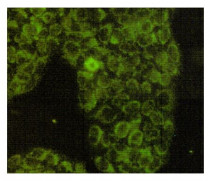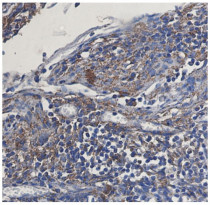ARG43597
anti-MTCO2 antibody
anti-MTCO2 antibody for Flow cytometry,ICC/IF,IHC-Formalin-fixed paraffin-embedded sections,Immunoprecipitation,Western blot and Human
Overview
| Product Description | Rabbit Polyclonal antibody recognizes MTCO2 |
|---|---|
| Tested Reactivity | Hu |
| Tested Application | FACS, ICC/IF, IHC-P, IP, WB |
| Host | Rabbit |
| Clonality | Polyclonal |
| Isotype | IgG |
| Target Name | MTCO2 |
| Antigen Species | Human |
| Immunogen | Synthetic peptide corresponding to a sequence of Human MTCO2. |
| Conjugation | Un-conjugated |
| Protein Full Name | Cytochrome c oxidase subunit 2 |
| Alternate Names | COII; MTCO2; COX2; Cytochrome c oxidase subunit 2; Cytochrome c oxidase polypeptide II; MT-CO2; COX21 Publication; COXII; mitochondrially encoded cytochrome c oxidase II |
Application Instructions
| Application Suggestion |
|
||||||||||||
|---|---|---|---|---|---|---|---|---|---|---|---|---|---|
| Application Note | * The dilutions indicate recommended starting dilutions and the optimal dilutions or concentrations should be determined by the scientist. | ||||||||||||
| Positive Control | HeLa, Human tonsil | ||||||||||||
| Observed Size | 21 kDa |
Properties
| Form | Liquid |
|---|---|
| Purification | Affinity purified. |
| Buffer | 50 mM Tris-Glycine (pH 7.4), 150 mM NaCl, 0.01% Sodium azide, 40% Glycerol and 0.05% BSA. |
| Preservative | 0.01% Sodium azide |
| Stabilizer | 40% Glycerol and 0.05% BSA |
| Concentration | Batch dependent |
| Storage Instruction | For continuous use, store undiluted antibody at 2-8°C for up to a week. For long-term storage, aliquot and store at -20°C. Storage in frost free freezers is not recommended. Avoid repeated freeze/thaw cycles. Suggest spin the vial prior to opening. The antibody solution should be gently mixed before use. |
| Note | For laboratory research only, not for drug, diagnostic or other use. |
Bioinformation
| Database Links | |
|---|---|
| Gene Symbol | MT-CO2 |
| Gene Full Name | mitochondrially encoded cytochrome c oxidase II |
| Function | Component of the cytochrome c oxidase, the last enzyme in the mitochondrial electron transport chain which drives oxidative phosphorylation. The respiratory chain contains 3 multisubunit complexes succinate dehydrogenase (complex II, CII), ubiquinol-cytochrome c oxidoreductase (cytochrome b-c1 complex, complex III, CIII) and cytochrome c oxidase (complex IV, CIV), that cooperate to transfer electrons derived from NADH and succinate to molecular oxygen, creating an electrochemical gradient over the inner membrane that drives transmembrane transport and the ATP synthase. Cytochrome c oxidase is the component of the respiratory chain that catalyzes the reduction of oxygen to water. Electrons originating from reduced cytochrome c in the intermembrane space (IMS) are transferred via the dinuclear copper A center (CU(A)) of subunit 2 and heme A of subunit 1 to the active site in subunit 1, a binuclear center (BNC) formed by heme A3 and copper B (CU(B)). The BNC reduces molecular oxygen to 2 water molecules using 4 electrons from cytochrome c in the IMS and 4 protons from the mitochondrial matrix. [UniProt] |
| Cellular Localization | Membrane, Mitochondrion, Mitochondrion inner membrane |
| Calculated MW | 21.7 kDa |
Images (3) Click the Picture to Zoom In
-
ARG43597 anti-MTCO2 antibody ICC/IF image
Immunofluorescence: HeLa cells stained with ARG43597 anti-MTCO2 antibody at 1:200 dilution.
-
ARG43597 anti-MTCO2 antibody IHC-P image
Immunohistochemistry: Paraffin-embedded Human tonsil stained with ARG43597 anti-MTCO2 antibody at 1:50 dilution.
-
ARG43597 anti-MTCO2 antibody WB image
Western blot: HeLa cell lysate stained with ARG43597 anti-MTCO2 antibody at 1:1000 dilution.








